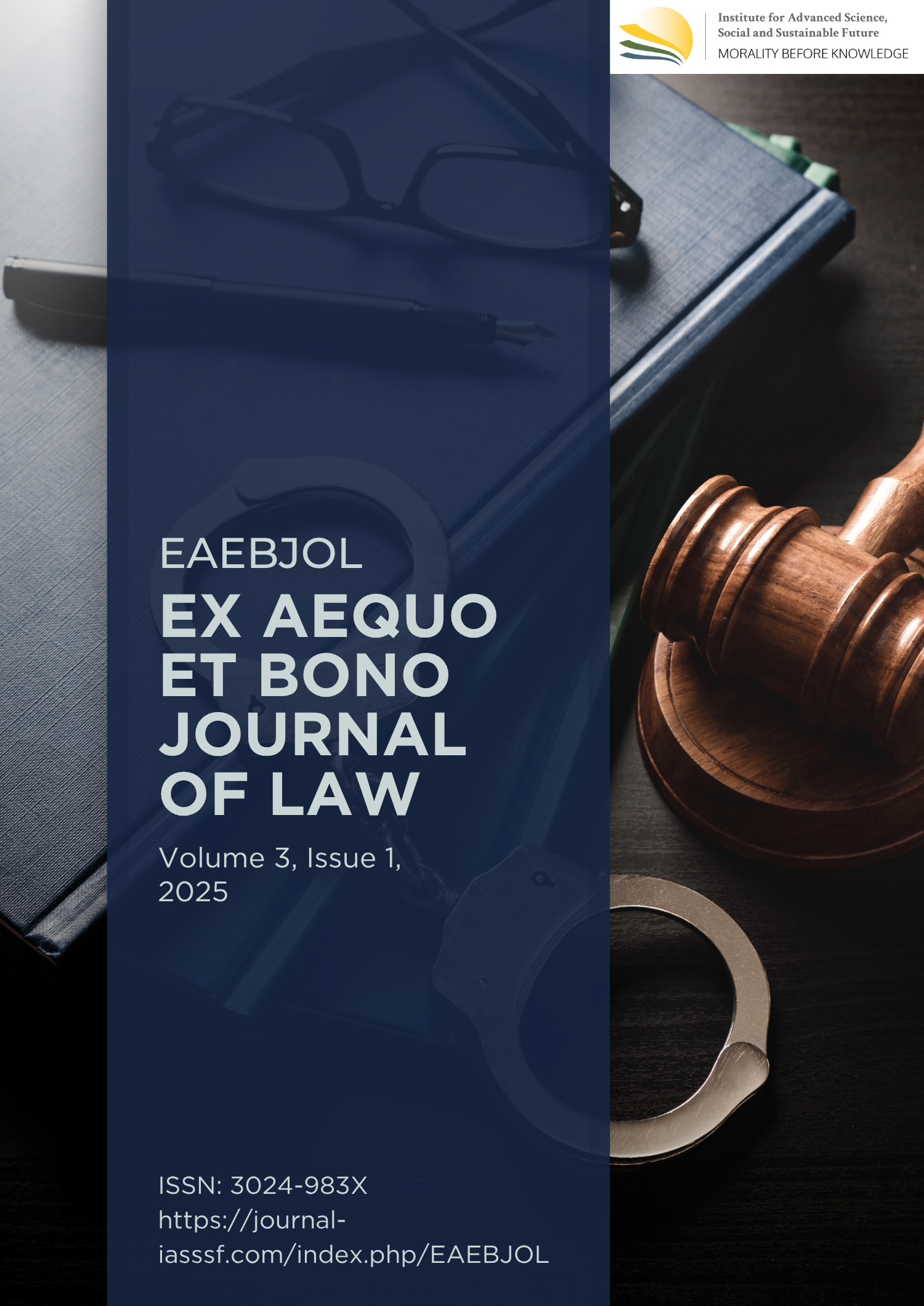Legal reform and the erosion of deterrence: Reassessing remission and conditional release policies for corruption convicts
DOI:
https://doi.org/10.61511/eaebjol.v3i1.2025.1970Keywords:
remission, parole, corruption, deterrent effect, reformAbstract
Background: Granting remission and parole to prisoners is the authority held by the Correctional Institution, in accordance with the provisions contained in Law Number 22 of 2022 concerning Corrections. The main requirement for obtaining remission and parole is the good behavior of the prisoner, and this provision applies to all prisoners without exception, including prisoners involved in criminal acts of corruption. Methods: This study uses the Normative Juridical method with a descriptive analysis approach. The research data was obtained through two sources, namely primary data from Legislation and secondary data obtained from interviews with Class IIA Tangerang Prison Officers. Findings: The results of the study show that the revocation of the Government Regulation has eliminated strict requirements related to granting remission to prisoners involved in corruption crimes, making it easy for corrupt prisoners to obtain it, it has eliminated the deterrent effect for perpetrators and the community. In response to this situation, total reform is needed, namely legal reform, law enforcement officers, and culture. Conclusion: The study concludes that the revocation of strict regulations has made it easier for corruption convicts to obtain remission, weakening the deterrent effect. Therefore, comprehensive reforms in law, enforcement, and legal culture are urgently needed. Novelty/Originality of this article: This article offers a critical and original analysis of the impact of regulatory changes on the remission process for corruption convicts in Indonesia. By combining normative legal review with firsthand insights from correctional officers, it highlights the unintended consequences of deregulation—specifically the erosion of deterrent effects—and emphasizes the urgent need for systemic legal reform, a perspective that has been underexplored in prior studies.
References
Agus, M. A., & Susanto, A. (2021). The optimization of the role of correctional centers in the Indonesian criminal justice system. Jurnal Penelitian Hukum De Jure, 21(3), 369–384. https://doi.org/10.30641/dejure.2021.V21.369-384
Anandya, D., Ramadhana, K., Easter, L., & Watch, I. C. (2021). Monitoring report on trends in prosecuting corruption cases in 2021. Indonesia Corruption Watch. https://antikorupsi.org
Carlsmith, K. M. (2006). The roles of retribution and utility in determining punishment. Journal of Experimental Social Psychology, 42(4), 437–451. https://doi.org/10.1016/j.jesp.2005.06.007
Corruption Eradication Commission Education Center. (2023). Corruption Perception Index. Corruption Eradication Commission. https://aclc.kpk.go.id/learning-materials/politic/infographics/corruption-perception-index
Darusman, Y. M., & Utami, I. S. (2020). The light judgment decision in the case of corruption: The implications for the sense of public justice. Jurnal IUS Kajian Hukum dan Keadilan, 8(1), 694–710. https://doi.org/10.29303/ius.v7i3.694
Estache, A., Goicoechea, A., & Trujillo, L. (2009). Utilities reforms and corruption in developing countries. Utilities Policy, 17(2), 191–202. https://doi.org/10.1016/j.jup.2008.07.002
Fazel, S., Hayes, A. J., Bartellas, K., Clerici, M., & Trestman, R. (2016). Mental health of prisoners: Prevalence, adverse outcomes, and interventions. The Lancet Psychiatry, 3(9), 871–881. https://doi.org/10.1016/S2215-0366(16)30142-0
Foster, A. (2023). Analysis of the mechanism of restitution and its impact on the financial recovery of the state due to corruption offenses. Interdisciplinary Journal and Humanity (Injurity), 2(7), 621–630. https://doi.org/10.58631/injurity.v2i7.96
Graycar, A., & Sidebottom, A. (2012). Corruption and control: A corruption reduction approach. Journal of Financial Crime, 19(4), 384–399. https://doi.org/10.1108/13590791211266377
Hamzani, A. I., Widyastuti, T. V., Khasanah, N., & Rusli, M. H. M. (2023). Legal research method: Theoretical and implementative review. International Journal of Membrane Science and Technology, 10(2), 3610–3619. https://doi.org/10.15379/ijmst.v10i2.3191
Hartanto, P., Ricky, R., & Gunawan, V. A. (2025). Using Indonesian corruption law for eradicating the Yogyakarta Sultanate land mafia: A legal formulation study. Indonesian Journal of Crime and Criminal Justice, 1(1), 23–53. https://journal.iueam.org/index.php/IJCCJ/article/view/122
Hidayat, S., Amiruddin, A., & Parman, L. (2024). Reformulation of certain circumstances indicator as a prerequisite for the imposition of death penalty in corruption crime. Jurnal IUS Kajian Hukum dan Keadilan, 12(1), 43–54. https://doi.org/10.29303/ius.v12i1.1350
Hutami, T., & Widjajanti, E. (2024). Imposition of cumulation criminal sanctions for the compensation money to the perpetrator of corruption. Amicus Curiae, 1(1), 22–31. https://ejournal.trisakti.ac.id/index.php/amicuscuriae/article/view/17177
Kholis, A. N., & Suharto, R. B. (2021). The implementation of passive removal granting for corruption criminal acts. Law Development Journal, 3(4), 757–766. https://doi.org/10.30659/ldj.3.4.757-766
Maroni, M. (2018). Problematic dilemma of the limitation of granting remission for corruption prisoners. Fiat Justisia, 12(2), 95–110. https://repository.lppm.unila.ac.id/8769
Mustamu, J., Bahri, S., Wahid, M. Y., & Ilmar, A. (2015). Freedom act (discretionary power) and its implementation as object corruption analysis of the decision number 2420 K/Special Crimes/2013 special criminal cassation cases. International Journal of Scientific and Research Publications, 5(9), 1–5. https://www.ijsrp.org/research-paper-0915.php
Negara, T. A. S. (2023). Normative legal research in Indonesia: Its originis and approaches. Audito Comparative Law Journal (ACLJ), 4(1), 1–9. https://doi.org/10.22219/aclj.v4i1.24855
Pandey, L. (2023). Remission and commutation of sentences: A social perspective. International Journal of Law Management & Humanities, 6(5), 1060–1070. https://doij.org/10.10000/IJLMH.115872
Rohman, M. M., Mu’minin, N., Mas’ud, M., & Elihami, E. (2024). Methodological reasoning finds law using normative studies (theory, approach and analysis of legal materials). MAQASIDI: Jurnal Syariah dan Hukum, 4(2), 204–221. https://doi.org/10.47498/maqasidi.v4i2.3379
Rukmono, B. S., Suwadi, P., & Islam, M. S. (2024). The effectiveness of recovering losses on state assets policy in dismissing handling of corruption. Journal of Human Rights, Culture and Legal System, 4(2), 299–330. https://doi.org/10.53955/jhcls.v4i2.259
Rumahorbo, M. H., Mahdewi, R., & Banjarani, D. R. (2022). The role of prosecutors in the effort for assets recovery from corruption crimes. Ius Poenale, 3(2), 81–92. https://doi.org/10.25041/ip.v3i2.2752
Setia, T. A., Ansari, T., Negara, S., & Brawijaya, U. (2023). Normative legal research in Indonesia: Its origins and approaches. Audito Comparative Law Journal (ACLJ), 4(1), 1–9. https://doi.org/10.22219/aclj.v4i1.24855
Sianturi, R. H., Simatupang, T., & Rahmayanti, R. (2015). Calculating financial state losses due to corruption in Indonesia: Financial state losses in whose eyes? Mediterranean Journal of Social Sciences, 6. https://doi.org/10.5901/mjss.2015.v6n3p124
Sudarti, E., & Sahuri, L. (2019). The sanction formulation in corruption crime due to Indonesian criminal law system to realize the punishment goals. Ganesha Law Review, 1(2), 55–64. https://doi.org/10.23887/glr.v1i2.54
Suharto, F. T. (2022). The role of mutual legal assistance in returning assets results of corruption. Jurnal Hukum Khaira Ummah, 17(4), 154–168. https://doi.org/10.30659/jku.v17i4.19313
Taekema, S. (2018). Theoretical and normative frameworks for legal research: Putting theory into practice. Law and Method, 2, 1–17. https://doi.org/10.5553/rem/.000031
Tamza, F. B. (2022). Prison penalty in providing a deterrent effect for criminal actions of corruption. Corruptio, 3(2), 87–100. https://doi.org/10.25041/corruptio.v3i2.2736
Villalpando, S. (2010). The legal dimension of the international community: How community interests are protected in international law. European Journal of International Law, 21(2), 387–419. https://doi.org/10.1093/ejil/chq038
Wahyuadi, B., & Warka, M. (2023). Return of state financial losses in corruption criminal acts. Technium Social Sciences Journal, 42, 86–99. https://doi.org/10.47577/tssj.v42i1.8657
Walle, G. V. (2010). The criminology of corruption. In The good cause: theoretical perspectives on corruption (pp. 1-32). Barbara Budrich.
Yanto, O., Rachmayanthy, R., & Satriana, D. (2019). Implementation of remission for female prisoners as one of the rights in the correction system. Jurnal IUS Kajian Hukum dan Keadilan, 7(1), 1–13. https://doi.org/10.29303/ius.v7i1.577
Downloads
Published
How to Cite
Issue
Section
Citation Check
License
Copyright (c) 2025 Annisthasya Desita, Ridwan

This work is licensed under a Creative Commons Attribution 4.0 International License.














